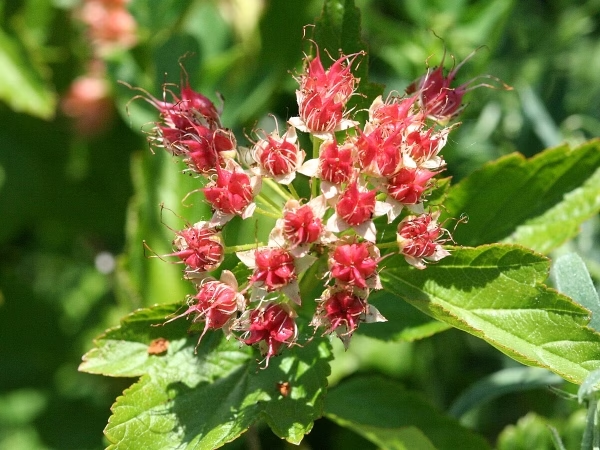
Ninebark
Botanical Name
:
Physocarpus opulifolius
Plant Type
:
Deciduous shrub
Seasons
:
Plant in early spring; blooms in late spring to summer
Sun Level
:
Full sun to partial shade (foliage color is richest in full sun of at least 6 hours daily)
Ideal Soil Temperature for Planting
:
65 to 75°F (18 to 24°C)
Soil Type
:
Clay, loam, or sand; tolerates a wide range of soils; dry to medium well-drained soils
Hardiness Zones
:
2–8
Germination
:
7 to 20 days after cold stratification
P.H. Level
:
Acid to alkaline soil (pH 5.0 to 8.0)
Water/Irrigation
:
Low; drought-tolerant
Fertilization
:
Use an all-purpose, slow-release fertilizer with a balanced NPK ratio, such as 10-10-10, in spring
Propagation
:
Seeds and cuttings
Final Plant Height
:
3–10 ft
Spread
:
3–8 ft
Flowers
:
Clusters of small, delicate white or pinkish flowers in late spring or early summer; five-petaled flowers appear in dense, spirea-like clusters
Attracts
:
Bees, butterflies and birds
Uses
:
Hedge plant, landscaping, container gardening, and erosion control
Companions
:
Elderberry, black-eyed Susan, coneflower, bee balm, aster, daylily, and wild bergamot
Pruning
:
In winter, cut foliage to the ground to promote growth in spring
Toxicity
:
Generally considered non-toxic but may stomach upsets in children
Pests
:
Good resistance to pests; few issues with blights or insects
Diseases
:
Good resistance to diseases; fire blight and leaf spot are possible
Fun Fact
:
Named for its unusual bark, which peels in strips to reveal several layers of reddish to light brown inner bark
Additional Info
:
It offers four-season interest; peeling bark provides year-round visual appeal
Botanical Name
:
Physocarpus opulifolius
Plant Type
:
Deciduous shrub
Seasons
:
Plant in early spring; blooms in late spring to summer
Sun Level
:
Full sun to partial shade (foliage color is richest in full sun of at least 6 hours daily)
Ideal Soil Temperature for Planting
:
65 to 75°F (18 to 24°C)
Soil Type
:
Clay, loam, or sand; tolerates a wide range of soils; dry to medium well-drained soils
Hardiness Zones
:
2–8
Germination
:
7 to 20 days after cold stratification
P.H. Level
:
Acid to alkaline soil (pH 5.0 to 8.0)
Water/Irrigation
:
Low; drought-tolerant
Fertilization
:
Use an all-purpose, slow-release fertilizer with a balanced NPK ratio, such as 10-10-10, in spring
Propagation
:
Seeds and cuttings
Final Plant Height
:
3–10 ft
Spread
:
3–8 ft
Flowers
:
Clusters of small, delicate white or pinkish flowers in late spring or early summer; five-petaled flowers appear in dense, spirea-like clusters
Attracts
:
Bees, butterflies and birds
Uses
:
Hedge plant, landscaping, container gardening, and erosion control
Companions
:
Elderberry, black-eyed Susan, coneflower, bee balm, aster, daylily, and wild bergamot
Pruning
:
In winter, cut foliage to the ground to promote growth in spring
Toxicity
:
Generally considered non-toxic but may stomach upsets in children
Pests
:
Good resistance to pests; few issues with blights or insects
Diseases
:
Good resistance to diseases; fire blight and leaf spot are possible
Fun Fact
:
Named for its unusual bark, which peels in strips to reveal several layers of reddish to light brown inner bark
Additional Info
:
It offers four-season interest; peeling bark provides year-round visual appeal
Written by Nondiah Khalayi – https://www.linkedin.com/in/nondiah-khalayi/

